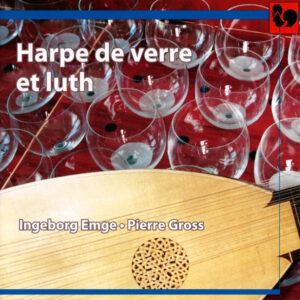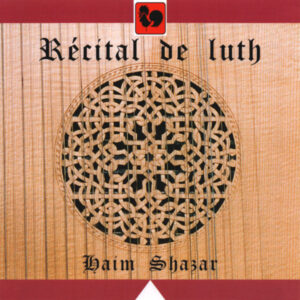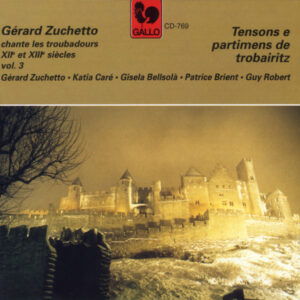Extraits / Excerpts
Italian Music for the Lute of the 16th and 17th Centuries - Ricardo Correa, Lute
Italian Music for the Lute of the 16th and 17th Centuries
Francesco CANOVA DI MILANO: Ricercare No. 1 – Ricercare No. 12 – Ricercare No. 5 – Ricercare No. 73 – Ricercare No. 34 – Ricercare No. 15 – Vincenzo CAPIROLA: La Villanella – Ricercare “La Spagna” – Che Farala Che Dirala – Albert DE RIPPE: Fantasie VII – Fantasie VI – Alessandro PICCININI: Balletto in Diverse Partite.
Ricardo Correa, Lute.
The Life of a Musician in 1500s Italy
How can the life of a musician in Italian society around 1500 be imagined? During this inventive yet tumultuous period, composers such as Vincenzo Capirola, Alberto da Rippa, and Francesco Canova da Milano played significant roles.
Francesco Canova did not stay long in the village near Milan where he was born in 1497. By the age of 13, he was already studying the lute with a famous musician in Mantua. Later, he entered the service of Pope Paul III, and likely his successors. Active mostly in Rome, Canova played the viola and the organ—he is even mentioned as the organist of the Milan Cathedral in 1530. However, he was primarily a lute player, and his listeners, enchanted by his virtuosity, nicknamed him “Il Divino” (The Divine).
Francesco Canova’s Repertoire
What did Canova play? In addition to improvisations on known or invented themes, he transcribed the works of his contemporaries, including motets and polyphonic songs. This practice of “mise en tablature” was common at the time and played a key role in the development of Renaissance instrumental music. Nevertheless, the most substantial part of his work consists of his Ricercare, with nearly a hundred surviving pieces found in various printed music collections from the 16th century.
Fantasy and Ricercare
The terms Fantasy and Ricercare were often used interchangeably to describe the same works, depending on the publisher or the country. Canova wasn’t the first to compose Ricercare—Petrucci had already published some in 1507—but with Da Milano, the Ricercare evolved into an elaborate instrumental form that encouraged experimentation and artistic freedom. No more vocal models or rigid melodic formulas! Each of Da Milano’s Ricercare became a unique piece. Notable examples include Ricercare 1, 12, 5, 73, 34, and 15 (Ness edition).
Ricercare 1 demonstrates clarity of construction, with its well-structured imitative entries flowing from high to low registers, interrupted by repeated cadences that divide the piece into shorter sections. By contrast, Ricercare 5 shares little resemblance, and even less so with “La Compagna” (Ricercare 34), where the second part stands out for its melodic energy. A line of short notes moves through different registers, repeating and transforming an initial motif of three sounds (D – E-flat – D), creating a new instrumental orientation, far removed from polyphonic transcriptions of motets and songs.
In Ricercare 12, the central part is built from brief sections, creating a fluidity that contrasts with the stillness of the opening, which is later revisited. Instead of a fixed theme, there is a sequence of repeating chords, with the D of the soprano heard over ten times, almost suspended in space.
Alberto da Rippa and Francesco Canova
There are several commonalities between Francesco da Milano and Alberto da Rippa. Both received their musical education in Mantua, where musical life was particularly vibrant at the beginning of the 16th century. However, while Francesco lived primarily in Rome, da Rippa was summoned to France in 1528 to reside at the court of Francis I, where he remained for the rest of his life. Da Rippa enjoyed a privileged position, with writers and poets from both France and Italy praising his ability to enchant audiences.
Sopra al sonar del Liuto del S. Alberto Mantovano
Quando la mar sovr’al Liuto move
Alberto, a cui no fu mai par, ne fia,
Ogni spirto gentil volendo via
Se ne va con suo suono in grembo a Giove.
His works, published only after his death in 1551, include Fantasia VI and VII, which display striking complexity within clear structures. Fantasia VI, for instance, is divided into four sections, opening with a rising bass line that is echoed by the soprano. This element isn’t fully developed but reappears at the beginning of the final section. Each of the two middle sections uses a different contrapuntal technique: free imitation dominates the second section, while in the third, a new voice repeats a brief motif, creating contrasts between the registers.
This technique of contrasting elements gives Fantasia VI a fascinating sense of unity and depth.
Vincenzo Capirola and Popular Influence
The works of Vincenzo Capirola, composed about 30 years earlier (circa 1520), follow a different path. His music integrates popular elements, with Dances, Ricercare, and polyphonic songs like “La Villanella” and “Che Farala Che Dirala”. The freshness of his compositions continues to captivate audiences even today.
The Lute in Italian Music History
A century later, the lute still held an important role in Italian music. However, by the time Alessandro Piccinini composed Toccatas, Gaillardes, Courantes, and Balletti, the instrument had changed. One significant modification was the increase in the number of courses (pairs of strings), from 6 to 13, which expanded the lute’s lower register.
In his “Balletto in Diverse Partite,” composed for the Illustrious Signor Conte Bentivogli, Piccinini plays with rhythms, transforming a unique theme into Pavanes, Gaillardes, Courantes, and Arias through numerous variations.
Piccinini was one of the last great Italian composers to write for the Renaissance lute. After him, musicians would turn to a new instrument: the Baroque lute, which dominated until the mid-18th century.
Denise Perret
Musicologist, Neuchâtel
(Adapted by ChatGPT)
- Categories
- Composers
- Interprets
- Booklet












